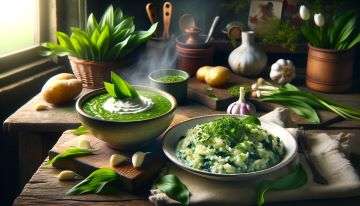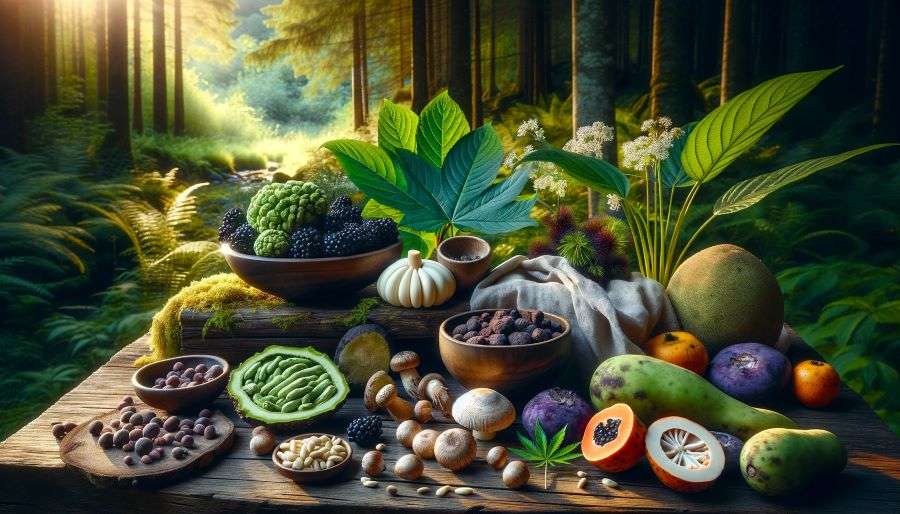This post contains affiliate links, through which we may earn a commission at no additional cost to you.
Table of Contents
Introduction
Set off on an epicurean quest amidst the lush landscapes of the world’s forests, journeying off the well-trodden tracks in pursuit of concealed culinary treasures nestled within their verdurous embrace. Today marks more than a mere saunter through the forest; it heralds an enthralling escapade into the woodlands to uncover a series of 10 unique forest foods, whose existence beneath the leafy canopy is a revelation to many. From the dim undergrowth to the majestic treetops above, each twist and turn on our trail is set to acquaint us with nature’s hidden abundance.
As we meander through this dense, forested feast, let’s awaken our senses to the array of flavors and textures poised to seduce us. Together, we will unearth the untold savors of the wilderness, where every foliage murmurs of age-old gastronomic mysteries, and every root carries the promise of newfangled gastronomical joy. Accompany us as we navigate this lavish and enigmatic terrain, where the earth’s generosity is limitless, and the next astonishing forest delicacy is merely a step away, eager to bewilder and exhilarate.
Wasabi from the Forest: the Fiery Revelation
The authentic wasabi plant (Wasabia japonica) thrives in Japan’s mist-covered, enigmatic forests. Unlike its commonly used counterparts, this bold herb prefers the moist environment of rivers and forest streams. Its unique taste, much sought after in culinary circles, originates from its vibrantly green rhizome. When grated, it offers a powerful yet swiftly vanishing heat and spice, differing from the prolonged sting of horseradish. This ephemeral spiciness and its singular scent render wasabi an irreplaceable ingredient in traditional Japanese dishes, enhancing the subtle flavors of raw seafood and sushi with a momentarily thrilling sensation. Discover this burning revelation in “The Wasabi Story” by Hiroshi Nakamoto.
Homemade Wasabi Creations
Dive into the creation of homemade products that capture the robust essence of wasabi with these two recipes:
Wasabi Salt
- Ingredients
- 2 tablespoons of dried wasabi powder, 1/4 cup of sea salt.
- Directions:
- Combine wasabi powder and sea salt well in a container.
- Apply the mixture onto a cook sheet and let it air-dry in a shadowy, excellent spot for about 24-48 hours.
- After drying, crumble any lumps and store the wasabi salt in an airtight container. It’s perfect for adding a novel zest to meats, vegetables, or popcorn.
Wasabi Mayonnaise
- Ingredients
- 1 cup of mayonnaise, 2 tablespoons of freshly prepared wasabi paste (adjust according to your heat preference).
- Directions
- Mix the mayonnaise with wasabi paste until it’s smooth.
- Tailor the wasabi quantity to suit your taste for spiciness.
- Keep the wasabi mayonnaise in a refrigerated, sealed container. It’s excellent as a zesty dip for fries, a flavorful spread on sandwiches, or a creamy side to sushi and seafood.
Innovative Wasabi Products
For those interested in exploring wasabi’s versatility, the market is filled with exciting products:
- Wasabi Paste: Typically made by grating the fresh rhizome or adding water to wasabi powder, this paste is a must-have at sushi counters around the globe for its convenience and distinct taste.
- Wasabi Powder: This dehydrated form can be turned back into a paste or used as a spice. It offers longevity and portability, appealing to both amateurs and culinary experts.
- Wasabi-Flavored Snacks: The unmistakable flavor of wasabi is now in various snacks, including wasabi peas, flavored nuts, and even wasabi ice cream, offering a spicy and enjoyable munching experience.
Cooking with Wasabi
Incorporate wasabi into your cooking for an innovative twist on regular dishes with these recipes:
Wasabi Mayo Dip
- Ingredients
- 2 tablespoons wasabi paste (or powder mixed with water)
- 1 cup mayonnaise
- 1 tablespoon soy sauce,
- 1 teaspoon lemon juice.
- Instructions
- Blend the wasabi, mayonnaise, soy sauce, and lemon juice until smooth. Adjust the wasabi amount to your preferred spiciness. Enjoy it as a dip with veggies or fries or as a sandwich spread for that extra zing.
Seared Wasabi Salmon
- Ingredients
- 4 salmon fillets
- 2 tablespoons wasabi paste
- 2 tablespoons soy sauce,
- 1 tablespoon olive oil,
- 1 teaspoon honey, salt and pepper as needed.
- Instructions
- Combine wasabi, soy sauce, honey, salt, and pepper. Marinate the salmon in this mixture for 15 minutes. Cook the salmon in heated olive oil in a skillet on medium-high heat, roughly 4 minutes per side, until cooked to your liking. Serve alongside rice and veggies for a delicious and nutritious meal.
Huckleberries: Wild Sweets of Nature
Huckleberries, often overlooked in favor of their more famous cousin, the blueberry, can be compared to the unnoticed heroes of football, playing an essential role yet frequently staying in the shadows. These wild berries flourish predominantly in the elevated woodlands throughout North America, presenting themselves as small, spherical treats that foragers are thrilled to discover.
The taste of huckleberries, varying from sweet to tart, lends them flexibility in cooking, usable in everything from classic pies to groundbreaking savory meals. Unlike blueberries, huckleberries primarily grow in the wild and are not easily farmed, making them more elusive and sought after. For those keen on exploring the intrigue of this berry, “Huckleberry: America’s Forgotten Fruit” by Susan Greene stands out as an informative guide, delving into its history, culinary roles, and conservation efforts.
DIY Huckleberry Creations
Huckleberry Jam

- Materials Required
- Fresh huckleberries, sugar, lemon juice, pectin, sterilized jars.
- Procedure
- Clean the huckleberries, ensuring all stems or leaves are discarded.
- Combine 4 cups of huckleberries, 2 cups of sugar, and 2 tablespoons of lemon juice inside a large pot.
- Heat until the sugar melts completely, stirring on a medium flame. Introduce 1 packet of pectin and boil vehemently.
- After boiling for 1 minute, take off the heat.
- Carefully spoon the jam into sterilized jars, keeping a 1/4-inch space at the top. Seal and put them in a boiling water canner for 10 minutes.
Huckleberry Syrup
- Materials Required
- Huckleberries, sugar, water, lemon juice, fine mesh strainer, storage bottles.
- Procedure
- Combine in a saucepan: 2 cups of huckleberries, 1 cup of sugar, 1 cup of water. Stir these ingredients together.
- After reaching a boil, lower the heat and simmer for 20 minutes.
- Inject a tablespoon of lemon juice to elevate the flavor.
- Utilizing a fine mesh strainer, filter the blend, pressing the berries to get as much liquid as possible.
- Transfer the syrup into bottles and keep chilled. It is an excellent topping for pancakes, waffles, or ice cream.
Products for Purchase
- Huckleberry Tea: This refreshing herbal tea, infused with dried huckleberries, provides a distinctive and refreshing flavor.
- Huckleberry Vinaigrette: This gourmet dressing melds the tartness of huckleberries with the depth of balsamic vinegar for a singular taste experience.
- Huckleberry Chocolate Bars: These craft chocolate bars are enriched with dried huckleberries, creating a compelling sweet-and-sour contrast that chocolate fans will find hard to resist.
Huckleberry Dishes
Huckleberry Pie
- Ingredients
- Fresh huckleberries, pie crust, sugar, flour, lemon juice, and butter.
- Directions
- Combine 4 cups of newly picked huckleberries with 3 3/4 cups of sugar, 3 tablespoons of flour, and 1 spoonful of lemon juice.
- Spread the berry blend into a ready pie crust, spot with butter, and cover with another crust.
- Preheat your oven to 425°F (220°C) and allow the item to cook for 15 minutes. After this initial period, you must adjust the oven’s temperature to 350°F (175°C). Continue baking it for an additional 45 minutes, or wait until you notice that the crust has adopted a lovely golden brown hue and the stuff inside starts to bubble up.
Huckleberry Pancakes
- Ingredients
- Pancake mix, fresh huckleberries, butter, maple syrup.
- Instructions
- Prepare the pancake mix as per instructions.
- Carefully incorporate 1 cup of fresh huckleberries into the batter.
- On a buttered skillet, cook the pancakes over medium heat until bubbles form on top, then flip to brown the other side.
- Enjoy them hot with butter and maple syrup for a mouth-watering breakfast option.
Pawpaws: The Overlooked American Fruit
Pawpaws, often celebrated as an unsung hero among fruits, have earned the distinction of North America’s most substantial native fruit. Flourishing beneath the Eastern U.S. forests’ canopy, these fruits stand as a testament to nature’s abundance, offering a taste that skillfully blends the sweetness of bananas with the unique zest of mangoes. Andrew Moore ventures into this overlooked fruit’s rich cultural and botanical story in his investigative work “Pawpaw: In Search of America’s Forgotten Fruit,” highlighting its historical importance and culinary versatility.
DIY Pawpaw Creations
Pawpaw Lip Balm
- Necessities
- 2 tablespoons of pawpaw puree
- 1 tablespoon of beeswax pellets
- 1 tablespoon of coconut oil
- Small receptacles
- Procedure
- Melt the beeswax and coconut oil together in a bain-marie over a gentle flame.
- After thawing, take it off the heat and briskly stir in the pawpaw puree.
- Transfer the blend into the small receptacles before it begins to set.
- Wait for the lip balm to cool down and harden before applying.
Pawpaw Hand Cream
- Necessities
- ¼ cup of shea butter
- 1/8 cup of sweet almond oil
- 1 tablespoon of pawpaw puree
- Optionally, any essential oil for scent
- Procedure
- Dissolve the shea butter using low heat in a double boiler.
- Incorporate the sweet almond oil into the melted shea butter, mixing thoroughly.
- After cooling a bit, add the pawpaw puree and blend well.
- For added aroma, infuse a few drops of the preferred essential oil.
- Transfer the concoction into a jar, allowing it to completely cool before sealing.
Available Pawpaw Products
- Pawpaw Jam: A delightfully tangy and sweet concoction that perfectly encapsulates pawpaw’s essence. It is a splendid addition to toast, pastries, or a cheese platter.
- Pawpaw Body Wash: Enriched with pawpaw extracts, this body wash rejuvenates and refreshes the skin, leaving behind a delicate, fruity scent.
- Pawpaw Nutritional Supplements: Offered in either powder or capsule versions, these supplements harness pawpaw’s health advantages, including essential vitamins, minerals, and antioxidants.
Pawpaw Recipes
Pawpaw Banana Smoothie

- Ingredients
- 1 ripe pawpaw, skinned and seeds removed
- 1 banana
- ½ cup of milk (any variety)
- A scoop of ice
- Honey for sweetness, according to taste
- Steps
- Toss all the ingredients into a blender.
- Puree until creamy.
- Add honey to achieve the desired sweetness.
- Serve straight away, decorated with a slice of either pawpaw or banana.
Pawpaw Bread
- Ingredients
- 2 cups of all-purpose flour
- 1 teaspoon of baking soda
- 1/4 teaspoon of salt
- 1/2 cup of unsalted butter, melted
- 3/4 cup of sugar
- 2 large eggs
- 1 cup of pawpaw puree
- 1/2 teaspoon of vanilla extract
- A half-cup of diced pecans or walnuts”(optional)
- Steps
- Warm your oven up to 350°F (175°C) and prep a 9×5 inch baking pan with grease.
- Mix salt, flour, and baking powder in a separate container.
- In a different bowl, cream the melted butter with sugar. Incorporate eggs individually, then blend in the pawpaw puree and vanilla.
- Slowly add the flour mixture to the pawpaw blend until combined. If you choose to use nuts, introduce them.
- Pour the batter into the ready pan.
- Bake for about 60-65 minutes until inserting a toothpick in the center is clean.
- Allow it to cool inside the pan for 10 minutes. Afterward, move it to a cooling rack to completely cool down.
Wild Mushrooms: Hidden Joys of Fungi
The underbrush of the woods is a haven for various mushrooms, a magical domain where the moist, nourishing earth, coupled with the shadows cast by giant trees, sketches the perfect backdrop for numerous fungi species to flourish. From the sought-after morel, celebrated for its distinctive honeycomb look and nutty taste, to the amber-colored chanterelle, adored for its spicy, full flavor and substantial texture, forests worldwide are abundant with fungal jewels. These woodlands shelter the fungi above and harbor an array of other mushrooms, each distinguished by its unique traits, tastes, and applications.
Among these are the elegant oyster mushrooms, notable for their expansive, fan-shaped demeanor and subtle flavor; the hearty porcini, a staple in Italian dishes; and the fascinating lion’s mane mushroom, reputed for its cognitive enhancement capabilities and a consistency that mirrors that of seafood. Emma Smith’s “Fungi Foraging” is an essential manual for delving into this captivating sphere. It is an invaluable resource for both the experienced mushroom enthusiast and the curious beginner, providing expert advice on identifying, collecting, and conserving these natural marvels.
Craft Your Mushroom-Based Products
Build Your Mushroom Cultivation Kit
- Necessities
- Mushroom spores or spawn, a cultivation bag with a built-in filter, sterilized grains or another type of medium, water, a spray mister, and a dark and warm environment.
- Steps to Follow
- Soak the medium in the cultivation bag, then mix in your mushroom spores or spawn.
- Close the bag and set it in a dark, cozy spot to allow the mycelium, the fungus’s vegetative component, to spread throughout the medium. This could last a few weeks.
- After complete colonization, move the bag to a spot with indirect sunlight and decrease the temperature slightly to encourage the mushrooms to fruit.
- Spritz the bag’s interior with water every day to keep it moist. Mushrooms are expected to start forming within one or two weeks.
Create Your Mushroom Essence
- Necessities
- Choose your desired dried mushrooms (like reishi for its health effects), a high-proof spirit (such as vodka or ethanol), a glass container, cheesecloth, and a colored dropper bottle for storage.
- Procedure
- Place the dried mushrooms in the jar until it’s half full, then pour the alcohol over them until fully submerged.
- Fasten the cover firmly and keep it in a chilly shaded area, for a month, shaking it periodically to mix well.
- After a month, filter the concoction through cheesecloth into another jar, pressing to extract as much liquid as possible from the mushroom bits.
- Pour the filtered essence into the tinted dropper bottles for convenient use. This tincture can be utilized for its potential health advantages, like improving the immune system or reducing stress.
Mushroom Goods Worth Buying
- Mushroom Coffee Mix: An innovative combination of ground coffee and healing mushrooms, such as lion’s mane and chaga, designed to increase mental sharpness and energy levels minus the typical caffeine tremors.
- Mushroom Health Supplements are encapsulated or powdered forms of various mushrooms, including reishi, cordyceps, and turkey tail, designed to promote general wellness, immunity, and vitality.
- Exquisite Mushroom Seasoning: This seasoning mix is made from dry and powdered high-end mushrooms, like porcini, shiitake, and morel. It is ideal for enhancing the taste profile of everything from broths and sauces to meats and veggies.
Delightful Mushroom Cuisine
Creamy Mushroom Soup
- Ingredients
- Two cups of assorted wild mushrooms (sliced)
- One onion (sliced)
- Two cloves of garlic (crushed)
- Four cups of broth made from vegetables
- One cup of heavy cream
- Olive oil
- Spices as per your liking
- Directions
- Heat olive oil in a sizable saucepan over a medium setting. Fry the onions and garlic until they’re tender.
- Incorporate the mushrooms and allow them to be cooked until they release moisture.
- Pour in the veggie broth and gently cook for around 20 minutes.
- Blend the soup until it has a smooth texture, return it to the pan, and integrate the thick cream. Tweak the flavorings to suit your taste.
- Dish up warm, possibly garnished with some freshly chopped herbs.
Garlic and Herb Sautéed Mushrooms
- Ingredients
- 2 cups of chanterelles or your choice of wild mushrooms
- 3 tablespoons of butter,
- 2 garlic cloves (minced),
- A selection of fresh herbs (like parsley and thyme), seasoned to taste.
- Instructions
- Carefully clean the mushrooms with a wet cloth and slice if necessary.
- Warm the butter in a large pan on medium flame. Add the garlic and cook it until it gives off its fragrance.
- Increase the temperature to medium-high. Next, place the mushrooms in the skillet, sautéing them until they become crunchy, and adopt a golden-brown coloration.
- Add the herbs, adjust the seasoning with salt and pepper, and cook for another minute.
- Serve immediately as an accompaniment or as a steak, chicken, or bread garnish.
Wild Garlic: Piquant Herb
Known affectionately as ramps, wild garlic is a bountiful gift from the forest, catering to our sophisticated taste buds with its crisp, garlic-like flavor. This green vegetable, typically seen carpeting forest floors, signals the arrival of spring, marking a seasonal transition with its soft foliage. Its appeal lies not only in its taste but also in its adaptability, and the pleasure of foraging it offers those pursuing its verdant riches. As Dennis Cotter discusses in “Wild Garlic, Gooseberries… and Me“, this leafy wonder extends beyond mere sustenance; it is a call to immerse ourselves in the seasonal rhythms and tastes of nature.
Do-It-Yourself Wild Garlic Creations
Wild Garlic Pesto: An essential method for capturing wild garlic’s lively, fresh essence. To craft your batch, gather a collection of wild garlic leaves, a selection of pine nuts (or substitute walnuts for a unique spin), Parmesan cheese, first-press olive oil, lemon juice, salt, and pepper to taste. Blend the leaves with the nuts and cheese, adding olive oil until you reach the preferred texture. Season it with a sprint of lemon juice, a pinch of salt, and a sprinkle of pepper for a unique zest. Please keep it in a sealed container in the refrigerator or freeze it for extended use.
Wild Garlic Infused Oil: A straightforward yet profoundly flavorful concoction. Start by sterilizing a glass container. Fill it up with clean, freshly picked wild garlic leaves. Over this, pour a premium oil, such as first-press olive or avocado oil, ensuring the leaves are fully covered. Seal it and leave the mix steep for at least two weeks in a calm and dark spot. Filter the oil into another sterilized container. It is a beautiful addition to salads, soups, and marinades, imparting a delicate garlic taste.
Commercial Wild Garlic Offerings
Wild Garlic Salt: A mix of dried wild garlic leaves with sea salt, ideal for flavoring meals.
Heated Garlic Vinegar: It delivers a zesty garlic flavor, perfect for salad dressings and marinades.
Wild Garlic Cheese: Several artisanal cheese producers blend wild garlic into their cheeses, creating a seasonal signature cheese.
Wild Garlic Recipes

Wild Garlic and Potato Soup: A smooth, comforting soup that showcases the gentle garlic taste of ramps. Begin by sautéing chopped onions in butter until they are soft. Add diced potatoes and vegetable broth, Heat the water until it starts bubbling, then lower the heat to maintain a gentle simmer, cooking the potatoes until they are tender.. Incorporate a bountiful amount of chopped wild garlic leaves, letting them wilt. Puree the soup until it’s smooth, season with salt and pepper, and introduce a dollop of cream for extra decadence.
Wild Garlic Risotto: A rich, flavorful risotto ideal for an evening in spring. Start fry a finely diced onion in olive oil until it turns translucent. Add Arborio rice, ensuring the grains are well-coated and shiny. Slowly pour in vegetable broth, continuously stirring until the rice becomes al dente. Mix in a generous amount of chopped wild garlic leaves, allowing the warmth to soften them. Enhance with grated Parmesan cheese and a touch of butter for a creamy consistency and luxurious taste.
Cloudberries: Golden Berries from the Arctic
In the frigid, northern woodlands of Scandinavia and Russia, cloudberries (Rubus chamaemorus) are uncommon yet esteemed. These golden, sour berries are a gatherer’s ambition. Experience this unique berry by treating yourself to wild cloudberry powder or jam.
Elderberries: The Immunity-Enhancing Berries
Elderberries in temperate forest areas have been a conventional medicinal mainstay for generations. Their immunity-enhancing qualities make them a forest jewel. “Elderberries: The Complete Guide” by Linda Johnson, delves into their benefits.
Pine Nuts: Tiny Troves from the Forest
Hidden within the cones of specific pine trees, we find pine nuts—crunchy and nutty to taste. These tiny powerhouses are fundamental to various cuisines. “The Pine Nut Cookbook” by Maria Rossi is a superb resource for pine nut enthusiasts.
Cacao: Seed of Chocolate
Deep in tropical rainforests lies the birthplace of our treasured chocolate – the cacao tree. These valuable pods start the journey from bean to bar. Delve into this transition in “Bean to Bar: America’s Craft Chocolate Revolution” by David Castellan.
Wild Rice: Grain from the Forest Fringe
Contrary to widespread belief, wild rice is not just an aquatic plant but also thrives in wooded wetlands. This grain is nutritionally rich. Get a deeper understanding of this distinctive grain in “The Wild Rice Cookbook” by Laura Pappas, exclusively at Powell’s Books.
Conclusion
Delving into the forest’s generous bounty unveils a world teeming with diverse and vibrant flavors that nature generously provides. Every bite of these wild foods transports us straight to the heart of the wilderness, offering flavors as varied as the landscapes from which they come. The fiery zest of wasabi, the deep woodland flavor of wild mushrooms, and the refreshing burst of huckleberries are just the beginning of this culinary adventure. These treasures of the forest not only broaden our taste experiences but also forge a deeper bond with the natural world.
Gathering these natural delicacies promotes a harmonious way of interacting with our surroundings, highlighting the importance of preserving the fragile ecosystems that provide them. By integrating these remarkable foods from the forest into our meals, we enhance the flavor of our dishes and honor the complex network of life that supports us. This journey of discovery satiates our appetite and feeds our souls, reminding us of the precious balance between humans and nature.
FAQs on Forest Foods
What is wasabi?
Wasabi is a Japanese horseradish with a strong, spicy flavor, used as a condiment.
How spicy is wasabi?
Wasabi delivers a potent, sharp spiciness that quickly hits the nose more than the tongue.
What does pawpaw taste like?
Pawpaw has a creamy, custard-like texture with a flavor reminiscent of bananas and mangoes.








